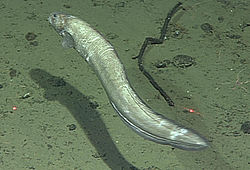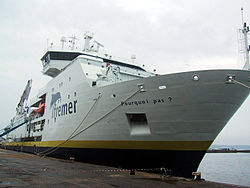- PERISCOP
-
The PERISCOP is a pressurized recovery device designed for retrieving deep-sea marine life at depths exceeding 2,000 metres.[1]:881 The device was designed by Bruce Shillito and Gerard Hamel at the Universite Pierre et Marie Curie.[2] The name is an acronym for the French phrase Projet d’Enceinte de Remontée Isobare Servant la Capture d’Organismes Profonds ("Enclosure project for isobaric ascent serving to capture deep organisms").[1]
Technology
The PERISCOP differs from previous pressurized recovery devices in that it contains separate chambers – one for capture, one for recovery under exterior pressure, and one for transfer to the laboratory while maintaining pressure. Previous recovery devices used one chamber for all purposes.[1]:882 An arm designed to capture samples by force of suction is attached to the device.[2] During ascent, pressure is maintained within the chamber by use of pressurized water. Pressurized gas was used in previous recovery devices, but it is not as safe as water.[1]:883 Temperatures below 2,000m usually range from 2-4 °C, and the device does not have a in-built cooling system. As a result, samples might experience heat shock until they are returned to their usual temperature by surface equipment.[2] Upon surfacing, samples can be observed, filmed, and/or photographed through transparent view ports in the device.[1]:884 Due to fluctuations in atmospheric pressure and temperature, the pressure in the device is not maintained perfectly. Recorded pressures during ascent and at the surface ranged from 74%-111% of the natural pressure.[1]:884
Experiments
The device set a new record for the deepest live-fish capture under pressure by capturing a live Pachycara at 2,300 m.[1]:887 The previous record was 1,400 m.[2] The capture was also the first to be performed at a hydrothermal vent.[2] The fish was reported to be alive and very active when observed on the surface.[1]:886 The device has also recovered several shrimp species (Mirocaris fortunata, Chorocaris chacei, and Rimicaris exoculata) at vent fields Lucky Strike and Rainbow.[2] Subsequent unpressurized captures of the same species resulted in stupefaction followed by death, indicating the necessity for such a device.[2] The experiments were performed from the Pourquoi Pas? during an IFREMER expedition.[2] Future experiments are planned to study the Pompeii worm, one of the most heat-tolerant animals on earth.[2]
References
- ^ a b c d e f g h SHILLITO, B; Hamel, Duchi, Cottin, Sarrazin, Sarradin, Ravaux, Gaill (1 July 2008). "Live capture of megafauna from 2300m depth, using a newly designed Pressurized Recovery Device". Deep Sea Research Part I: Oceanographic Research Papers 55 (7): 881–889. doi:10.1016/j.dsr.2008.03.010. http://www.ifremer.fr/momarsat2010/biblio/Shillitoetal_2008.pdf. Retrieved 18 February 2011.
- ^ a b c d e f g h i Lever, Anna-Marie (31 July 2008). "Live fish caught at record depth". BBC News. http://news.bbc.co.uk/2/hi/7525552.stm. Retrieved 18 February 2011.
Categories:- Fish
- Aquatic organisms
- Oceanography
- Research methods
Wikimedia Foundation. 2010.


